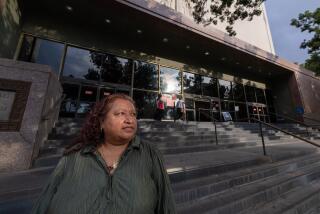Welfare Reform’s Enforcers
- Share via
Sitting with the poor, sometimes troubled people who have come for help, welfare caseworker Martha Soria is a vision of brisk but attentive efficiency. Those are traits she learned years ago while working in the travel industry, and are no less useful in Los Angeles County’s vast welfare system.
On this day, she is applying a patient eye to Vicente Granados, a 38-year-old married father of two whose life is falling apart. His 36-year-old wife has been stricken with leukemia, he is out of work after the steel mill where he had been employed for 12 years closed down, he’s been depressed and admits he’s been drinking.
The Granadoses were recently found eligible for public assistance and their case assigned to Soria. Before 1996, when the nation’s welfare laws were radically altered, such families might have gotten a monthly welfare check for the rest of their lives. Soria’s job would have been mostly to shuffle their paperwork. But with welfare reform came time limits on such benefits and strict new work requirements.
And while Soria still shuffles a lot of paperwork, her job as well as the jobs of welfare caseworkers across the state and nation have changed. They have had to master hundreds of new rules and regulations under welfare reform and take on new responsibilities as guidance counselor, job finder, cheerleader, taskmaster and sob sister to people like Vicente Granados.
Front-line workers are the enforcers behind the dramatic declines in national welfare caseloads, from 5 million families in 1994 to 2.1 million last year.
Most of those declines, though, were made during an economic boom. Today’s more uncertain economy will provide a crucial test as Congress prepares to renew welfare reform laws. The House of Representatives recently approved a bill, supported by the Bush administration, that stiffens work requirements even more. The Senate will next take up the issue.
“Caseworkers are a vital link in welfare reform,” said Pamela Holcomb, a senior researcher at the Washington, D.C.-based Urban Institute. “When you get down to it, the client and the caseworker interacting and how good a connection can be made at that basic level is critical.”
In many ways, caseworkers are under almost as much pressure as participants on the job hunt. In Los Angeles, workers have begun to mail out notices of approaching five-year federal time limits for cash aid.
About 25 of the 90 families in Soria’s caseload could lose partial benefits as early as January. She has to personally contact each head of household to remind them of the looming cutoff and the impact it could have on plans for schooling, counseling and job training. (In California, only adults will lose the cash grants, while retaining Medi-Cal and food stamps; children will keep full benefits.)
Caseworkers are very much aware of how their own jobs could become more stressful if Congress steeply increases work requirements for welfare recipients. But many also say that welfare reform was a needed corrective to a system that long fostered dependency.
“There is pressure on people because of the time limit and it’s kind of scary,” said Soria, 44, who works out of the county’s Rancho Dominguez office. “But they have had five years to plan for this.”
One of her clients is not so sure about the upside of welfare reform. Lawana Gordon, a 41-year-old mother of four who could be among the first to lose benefits, worries about whether she and her two youngest children will make ends meet if that happens. In addition to the family’s monthly cash aid of $443, about a third of which is Gordon’s share, she earns minimum wage working part-time providing in-home care. She would like to complete training to become a certified nurse’s assistant but feels the time-limit urgency.
“It seems unfair because they don’t know my individual situation, but it’s out of my control,” said Gordon after meeting with Soria to discuss her plans.
Soria told Gordon that the county is planning workshops for recipients in line to lose benefits but that there are few details. More pressing is getting Gordon an appointment with counselors to discuss emotional strains brought on by her parents’ deaths in recent years as well as worry over her future.
“I will overcome all of this,” Gordon tells Soria. “The most important thing is protecting my kids, but I’m hanging in there.”
To help people like Gordon hang on, Los Angeles County employs about 1,710 eligibility workers, who do the initial interviews of welfare applicants and determine the level of aid. Once eligible, participants are sent to one of 773 case managers, who are paid between $2,433 and $3,538 a month. Soria was an eligibility worker for seven years before being promoted to case manager three years ago.
The job used to focus on helping clients receive benefits, Soria said, adding: “Now we’re doing more customer-service work, but at the same time trying to promote responsibility.”
Among Soria’s expanded chores is to monitor participants’ work--single parents must be engaged in work-related activities for 32 hours each week, a married head of household for 35 hours--and the progress of clients in approved college classes. To keep up with the new rules, caseworkers like Soria attend weekly training sessions on such topics.
A New Client Begins
the Orientation Process
The Granadoses are among the newest of Soria’s cases. They are among the more than 16,000 two-parent households in the county’s welfare caseload, which numbers in excess of 191,000 families.
Vicente Granados is a thin, florid-faced man with a mustache and a nervous tic. His jaws work strenuously on piece of gum as Soria explains the process. They sit in Soria’s small, tidy office, one of dozens of similar gray cubicles in the large room that give the space the appearance of an accounting firm.
Across her desk, Soria passes paper after paper--some explaining the welfare program, some his rights and responsibilities--which Granados must sign. She then sends him to an orientation where he will see a motivational video, talk about success stories and be screened to determine his literacy.
After the orientation, Soria intends to assign him to a three-week program called Job Club, where he’ll be provided with a phone and job listings and be expected go out for interviews.
Because his wife is ill, Granados could get a medical exemption from working to care for her. But he wants to work and Soria encourages him because of the financial benefits.
Monthly cash aid for a family of four is less than $600, but Granados would be able to keep most of his salary from a job, and depending on his wages, a portion of the cash aid. The county would also help him obtain the certificate he needs to work a forklift. In addition, the family would probably qualify to have a county-paid nurse help out in the home.
With Granados in orientation, Soria attends to the rest of her day--updating her cases on the computerized system, phoning participants who might have missed a meeting or failed to turn in required paperwork, receiving calls from people who want appointments or just need a word of encouragement.
In many instances, two-parent households like the Granados family face more barriers than single mothers because they usually are immigrants with limited English skills. But these are the families Soria believes she works with best, perhaps because their lives parallel those of her own kin.
Her mother, Maria Aurora Cardenas, who is now 80, arrived from Mexico in the 1960s with six children to care for after her husband passed away. She had only a second-grade education and still doesn’t speak English very well, though she understands it, Soria says.
Soria wanted to become a flight attendant but she was 2 inches too short. She settled for a ground job, first as a reservation clerk and then as a travel agent handling business clients for Aeromexico until the financially troubled airline laid her off.
She had gone back to school to become an court interpreter when a friend told her the county welfare office was hiring.
During her first weeks, Soria cried along with the mothers who recounted how they were homeless or couldn’t feed their children. She almost quit but stuck it out, she says, because her husband had been laid off and they were buying a house. She has been cursed out, glared at and insulted by uncooperative welfare participants, but it all becomes worthwhile, she says, when people later succeed in life and thank her.
Almost on cue, Soria gets a call from one of her cases, a woman whose husband is ill and can’t work. Soria encouraged her to get a certificate as a preschool teacher. Often during visits, the woman would break down, saying she couldn’t go on. Now she calls to say she has gotten a job and a promotion already.
Soria has little time to savor that upbeat moment. Another case is waiting.
Felisiano V. Salazar Sr. is a 52-year-old man with a 49-year-old wife at home and three children. Salazar had done odd jobs as a mechanic and heavy equipment operator but has been out of work since September. He’s already been through Job Club once, with no success. His English is not very good, and Soria decides to schedule an assessment to determine if there are other barriers.
“We can probably find him a job, but it’s going to take more effort than with a younger person,” Soria says, after sitting Salazar down with job developer who works in the office.
New System ‘Is Difficult for Everybody’
Later in the week, Soria will learn that Salazar for the second time has missed his appointment for an assessment. Unable to reach him by phone, she schedules an appointment by mail. Soria then will have to decide whether Salazar’s inaction merits reporting as a possible infraction, which could cause the family to lose a portion of its cash aid.
In Los Angeles County, “workers and participants are caught in a new system that is difficult for everybody,” said Madeleine Stoner, a USC professor of social work who has examined the county’s welfare program. “There have been computer blips and people have been wrongly sanctioned. It’s been a very dysfunctional system.”
Soria, though, thinks the ethos is slowly changing. Many offices have been revamped, with plush carpeting and new paint intended to create an atmosphere of professionalism. Both participants and workers seem to be more cordial, she says.
But with the federal government proposing to keep welfare funding--about $16.5 billion last year--static and California facing a projected $17-billion budget shortfall, money for many services is in jeopardy.
At the same time, the Los Angeles County Department of Public Social Services, which administers welfare programs, is facing a $100-million deficit. Although officials hope to avoid layoffs, vacancies will go unfilled and workloads will increase, Director Bryce Yokomizo said.
Back in her office, Soria is still grappling with the best way to help the Granados family. She is ready to schedule the father for Job Club. Because he indicated he has a drinking problem, he first must see a substance abuse specialist.
A few days later, Soria learns that Granados missed his appointment because his wife had to enter the hospital and he must baby-sit the children. He told Soria he is trying to decide what should be a priority: getting the services he needs to provide for his family or staying home to care for his wife.
In Soria’s view, taking a job, with its financial benefits, would relieve some of the pressure on Granados, “but ultimately he will have to reflect on that,” she said.
Her own mother almost applied for welfare when Soria was a child. She was handed reams of paperwork in a language she didn’t understand by workers who were not very sympathetic. So, she walked out, she told Soria many years later.
Be happy you have the stability of a county job, but, more important, she told her daughter, be nice.
Those words have guided her, Soria said: “You have to have compassion in this job. You always have to realize it’s very possible you could be sitting on the other side of the desk.”
More to Read
Get the L.A. Times Politics newsletter
Deeply reported insights into legislation, politics and policy from Sacramento, Washington and beyond. In your inbox twice per week.
You may occasionally receive promotional content from the Los Angeles Times.











